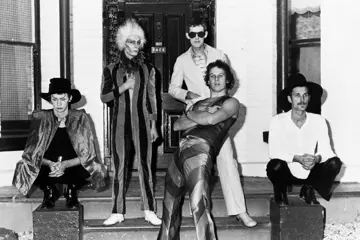THE TALE OF the PRINCESS KAGUYA

In its most striking moment, The Tale Of The Princess Kaguya finds its titular heroine — a mythical figure found in a bamboo shoot, who rapidly grows into a figure of royal wealth and social privilege — fleeing, in a flight of fantasy, back to the rural hamlet in which she was raised, desperately attempting to return to the lost innocence of swiftly-disappeared childhood. It’s a dream sequence that’s never so rote, more a symbolic journey into its main-character’s inner mind. And director Isao Takahata — the less-famous pillar of Japanese animation legends Studio Ghibli — stages it in an unforgettable flurry of impressionist pencil scribblings, as if his Princess is hoping to run so fast she comes off the page, flies off the screen, escapes the reality in which she’s being held.
Takahata’s first film in 14 years is a work of lyrical hand-drawn style, trying to preserve the fluency and movement of sketchwork by keeping the rough pencil lines and eraser marks in, with each frame hand-painted in blotchy, aqueous water-colour. The process means that the film forever moves on screen, alive and dancing. And, it meant The Tale Of The Princess Kaguya took eight years to make. But for anyone who’s winced through decades of ugly 3D animations, it feels like a gift you’ve been waiting a lifetime for.
For anyone who’s winced through decades of ugly 3D animations, it feels like a gift you’ve been waiting a lifetime for.
Takahata is adapting of an ancient Japanese folktale, The Tale Of The Bamboo Cutter, in which a pair of elderly rural workers find a sprite glowing in a bamboo grove, watch as she grows into a princess, declines the overtures of a host of eager suitors — including the emperor of Japan himself — only to, finally, return to the home from which she came: the moon. The hand-drawn and hand-painted quality touch on traditional folk art, but there’s a psychedelic quality, too, to the way the film wobbles and wanes, to how its ‘reality’ seems so malleable, so dreamlike.
Don't miss a beat with our FREE daily newsletter
Its folktale is, ultimately, a valentine for a simple life, for the human connection to nature; society, with all its rules and repression, a place unnatural and unforgiving. Once Princess Kaguya becomes a princess, she is the caged bird; disconsolate and melancholy, a figure of yearning. And, in the moments in which that yearning leads into dreaming — be she tearing through the countryside in a grey-lead flurry, or, in a classic Studio Ghibli moment, taking flight hand-in-hand with another — the film feels like animation in its most classic, most powerful form: offering earth-bound viewers a place of fantastical escape.
ISAO TAKAHATA & HIS TALE OF THE PRINCESS KAGUYA

THE KINGDOM OF DREAMS AND MADNESS

The arrival of The Tale Of Princess Kaguya has brought with it a Studio Ghibli season enshrining the latest — and likely last — feature films from company staples Isao Takahata and Hayao Miyazaki (for the latter, The Wind Rises, commercially released early in 2014). They’re being screened alongside their respective 1988 classics, Grave Of The Fireflies and My Neighbour Totoro, and a pair of documentaries showing each director at work. Both Isao Takahata & His Tale Of The Princess Kaguya and The Kingdom Of Dreams And Madness were made for Japanese television — the latter not even as feature, but two episodes of hour-long TV — and work solely as companion pieces for the feature films; less stand-alone artworks than bundled DVD extras.
They’re old friends and sparring partners, but they’re striking in their differences.
Which isn’t to say that Studio Ghibli devotees won’t find delight in going behind the scenes of these makers of magic; and spending quality time with Takahata and Miyazaki as they go about work, still slaves to the grind deep into their 70s. They’re old friends and sparring partners, but they’re striking in their differences: Miyazaki the beloved company-man who draws every frame himself, Takahata the reclusive visionary who never picks up a pencil.
The Kingdom Of Dreams And Madness has more of a sense of reverence; Miyazaki, the smiling, beneficent patriarch presiding over a workplace that feels like a family, producing artworks of bountiful joy. Worshiping at the shrine of one of cinema’s great deities lessens its dramatic edge. In contrast, The Tale Of Princess Kaguya is a film about a far-less-prolific, far-more-problematic filmmaker: Takahata having never made a film that was turned in on-time or on-budget. Grave Of The Fireflies may be an unquestioned classic of the animated medium, but there are plenty of questions about Takahata’s devotion to time-consuming, labour-intensive animation practices out of sheer artistic preference. Music fans will also feels blessed when, mid-Isao Takahata & His Tale Of The Princess Kaguya, amazing cult artist Nikaido Kazumi blows into frame to sing the theme for Takahata’s film; her voice, alone, giving the documentary a reason to exist.
THE WONDERS

INCOMPRESA

Unless you’re big on ribald commercial comedies, the Italian Film Festival usually offers pretty slim pickings. 2014 sure ain’t too different, but it does boast a couple of films of genuine interest, Alice Rohrwacher’s The Wonders and Asia Argento’s Incompresa, each of which premiered at Cannes this year (where Rohrwacher won the Grand Prix). Aesthetically, they couldn’t be more different — the former a piece of lyrical, rural socio-realism; the latter a hyper-stylised adolescent grotesquerie — but they’re totally comparable: each the directorial work of a celebrated actor, in which an oddball childhood growing up in extreme circumstances is recounted as cinematic memoir.
The Wonders, Rohrwacher’s directorial debut, takes place in that distant turn-of-the-’90s day in which bees were still alive, throwing itself into beekeeping, the family-business in which the filmmaker (and her sister, who also stars) were raised. Maria Alexandra Lungu is the eldest of four daughters at an apiary in dusty coastal Tuscany, a dutiful daddy’s-girl devoted to the endless toil of honey production. Her parents — a German father (Sam Louwyck), a French mother (Alba Rohrwacher) — started the farm as experiment in back-to-the-land communal living, but their utopian dreams have given way to capitalist grind; every drop of golden honey squeezed for every possible lira. It’s a mom-and-pop operation in the dying days of old-fashion farming, the dawn of industrialised agribusiness looming: the farmers association bringing in new regulations; a local hospital frowning upon their unsafe working practices; a TV talent-show for farmers just thinly-veiled bureaucratic snooping. But for Lungu, starting to resent life in the middle-of-nowhere with the onset of adolescence, the glamour of the program — and its host, Monica Bellucci — feels like a window unto another world, a promise of a better life. A piece of ridiculous kitsch so inexplicably tacky it seems true to Italian television, the show-within-the-movie trusses its rural farmers up in the costumes of the Ancient Etruscans, the long-ago society that once inhabited these coastal climes, before mysteriously disappearing into history. Rohrwacher uses them as an obvious simple for the fading way-of-life of these old-fashioned bee-farmers; a memorable final shot showing The Wonders’ rag-tag family vanishing into thin air.
Incompresa marks the third directorial work of Argento; who was so burnt after her experiences adapting JT LeRoy’s The Heart Is Deceitful Above All Things — at buying into the truth of that great literary sham — that she didn’t know if she could ever direct again. A decade later, she returns with a film that isn’t too far gone: another coming-of-age psychodrama about a child being dragged through the drugged-out lives of unfit parents. If her prior picture came from a made-up memoir, here, Argento authors a fantastical, hysterical tale that draws deep from her own childhood. After making her directorial debut, Scarlet Diva, when she was just 23, Argento was 37 when she set out making Incompresa; and she’s clearly in a reflective mode. Its coming-of-age tale inhabits the mind of neo-adolescent Aria (Giulia Salerno), lost in the wasteland between her freshly-divorced folks, each (fake-tanned father Gabriel Garko, strung-out mother Charlotte Gainsbourg) celebrities ensconced in sheer self-obsession, harbouring little interest in parenting. Incompresa — due to be called Misunderstood in America — is less about finding your way in the world than creating your own interior world; at navigating the terrors of one’s teenage years by bending reality to suit your mindset. Though adrift between the twin celestial bodies of parents as powerful, worshipped, and ultimately indifferent as Gods, Salerno isn’t taking her fucked-up childhood lying down; her impish insouciance, sense-of-humour, and fondness for misadventure equal parts childlike wonderment and clung-to-coping mechanism. When not luxuriating in tragic ’80s kitsch, Argento makes her heroine a real human amidst a sea of screeching caricatures; the only sane person in a batshit family, coming-of-age in a world gone to hell.















